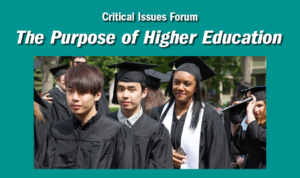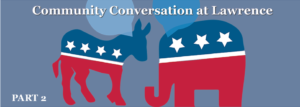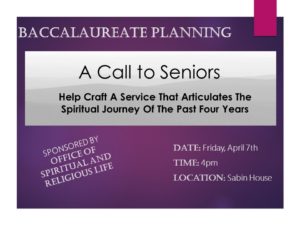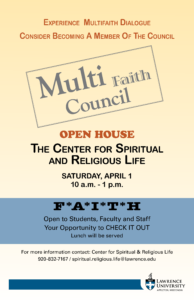
Come and share ideas on April 14, 2017 • 11 am – 1 pm
Thomas Steitz Hall of Science Atrium
Please RSVP to michelle.l.lasecki-jahnke@lawrence.edu by April 10.


Come and share ideas on April 14, 2017 • 11 am – 1 pm
Thomas Steitz Hall of Science Atrium
Please RSVP to michelle.l.lasecki-jahnke@lawrence.edu by April 10.

March 31, 1–4 p.m.
Esch Hurvis Room, Warch Campus Center
Facilitators:
Kimberly Barrett, vp for diversity & inclusion and associate dean of the faculty
Jenna Stone, executive director of budget and planning
Community Conversations at Lawrence University are a series of structured dialogues that facilitate authentic communication across some critical area of perceived difference. The purpose is to practice civil deliberation while promoting greater intergroup understanding and trust. We want to help participants begin to move beyond political orthodoxies in order to see ourselves
as diverse but related travelers on life’s journey together with shared concerns and values. It will also serve as a basis to develop collaborative strategies to increase the well-being, civility and participation of people across the political spectrum in all aspects of the life of our campus.
Please RSVP to michelle.l.lasecki-jahnke@lawrence.edu.
Register today to attend this year’s Career Symposium, featuring opportunities for every major!
Engage with over 25 alumni including Ali Heiring ’16, Adam Ferguson ’10, Michelle Li ’12, Syed Abbas ’11, Tara Jensen ’14, Sandy Murti ’95 and Jaime Harper ’83 from companies like Google, Facebook, Deloitte, Mercer and Citadel.
• Explore unanswered career questions
• Expand your professional network and
• Envision your future!
Sessions include consulting, arts administration, social impact, networking, technology, market research and a special What to do with a Government Major panel.
There are also multiple opportunities to chat with alumni on a 1:1 basis! Contact Career Services to schedule a time.
Please register in LUworks (search “career symposium”) as room capacity is limited and space may fill. Walk-ins will also be welcome on the day of each event as space allows.
If you are interested in helping Lawrence University become a more inclusive community, join one of our allies network group sessions to learn more.
Staff – Thursday, March 30 (11:30-12:30 pm)
Students – Thursday, March 30 (7-8 pm)
All group sessions are in the Esch Hurvis Room
Please RSVP to Michelle Lasecki-Jahnke at michelle.l.lasecki-jahnke@lawrence.edu
A Call to Seniors:
Join Linda Morgan-Clement and your fellow classmates in shaping a celebratory message that will resonate for years to come. Being a part of this important service means being passionate about the message that will foster the class of 2017 in a new direction. Help craft a service that articulates the spiritual journey of the past four years.
April 7th, 2017 • 4pm • Sabin House


August 17-18
Teaching All Students Well
Proposals are due April 7.
Sessions can be either 50-minute presentations (with question-and-answer periods) or 80-minute panels or interactive activities. They should directly address the conference focus on inclusive pedagogy.
Potential topic areas include:
Proposals should include:
Questions?
Call 920-832-6744 or email michelle.l.lasecki-jahnke@lawrence.edu
Effective March 23, 2017 the plaza between Mudd Library and Wriston Art Center will be closed to vehicular and pedestrian traffic. Art students may access Wriston at the ramp on the north east end of the building. The shuttle will continue to operate as normal.
There is absolutely NO parking in the Wriston turn around. This area is reserved for the Fire Department. You will be ticketed and towed at your expense for parking in this area.
Thank you for your cooperation. The project completion date is May 31.

If you are interested in helping Lawrence University become a more inclusive community, join one of our allies network group sessions to learn more.
Staff – Thursday, March 30 (11:30-12:30 pm)
Students – Thursday, March 30 (7-8 pm)
All group sessions are in the Esch Hurvis Room
Please RSVP to Michelle Lasecki-Jahnke at michelle.l.lasecki-jahnke@lawrence.edu
Positions are still available for students interested in working (and living) on campus this summer! We have several opportunities in Facilities and Campus Services to help with painting, lawn care, moving furniture, and completing general maintenance duties. Please contact Lindsay Kehl (x7136) if you are interested in one of these opportunities.
Get to know each other. Find meeting dates. Do some basic starting dialogue…and eat lunch. This is a chance for folks to see what it might be like before making the commitment to be a council member.
Saturday, April 1 • 10am – 1pm • The Center for Spiritual and Religious Life
